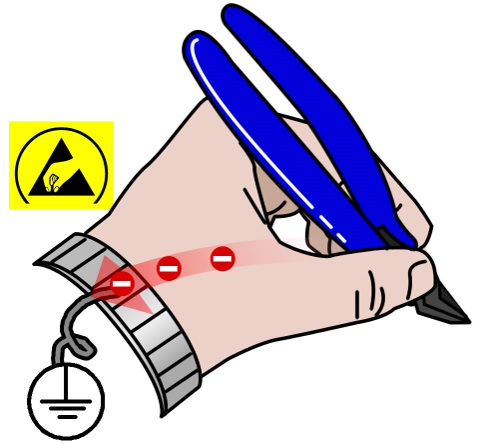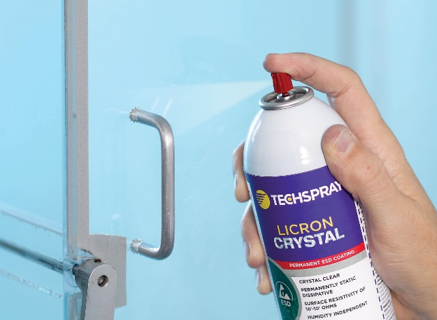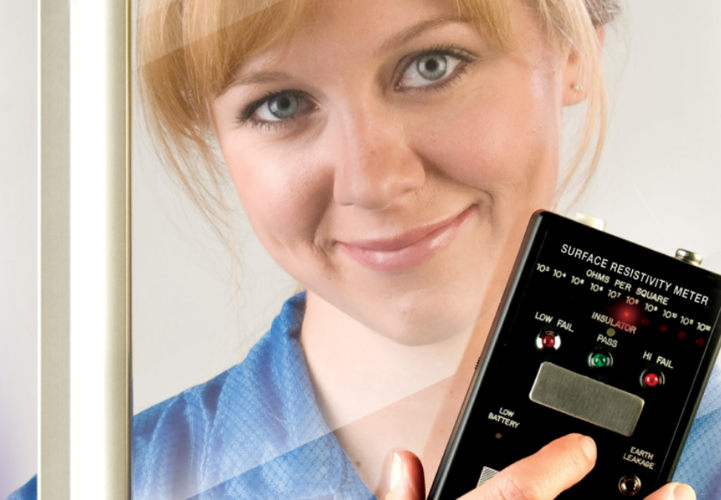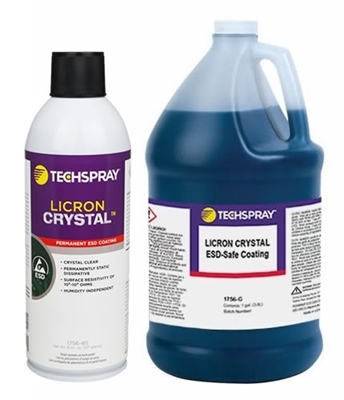EMS and PCB repair facilities that work with static sensitive equipment are very familiar with ANSI/ESD-S20.20 and the challenge of maintaining compliance. You buy all the right benches, mats, straps, bags and more at a steep premium. Then in comes a stray plastic bin, cart, or tool that, although necessary, puts the whole program into question during a customer audit.
That’s where Licron Crystal can save the day.
Techspray Licron Crystal Permanent ESD-safe Coating is a versatile, transparent urethane coating that adheres to metal, plastic, and most other surfaces. It is ideal for converting standard bumpers, bins, tools, and surfaces to ESD-safe, saving expensive replacement costs. The end result is compliant with ANSI/ESD-S20.20, which prevents static damage to sensitive electronic components.
Licron Crystal operates in any humidity, from 0 to 100%, unlike other temporary coatings which rely on absorbed moisture from the air. The resultant cured coating is durable, will not chip and maintains 107-109 ohms resistivity. Licron Crystal can be sprayed as an aerosol or using a standard spray gun system. As long as the coat is thin, smooth, and even, the finish will be transparent. A grounding wire can then be attached (i.e. by conductive adhesive) similar to an ESD floor.
So to summarize the benefits and properties of Licron Crystal:
- Rugged static dissipative coating
- Superior adhesion to a variety of surfaces: glass, plastic, metal, etc.
- Surface Resistivity of 106 to 109 ohms
- Humidity independent
- Transparent finish (if applied thinly and evenly)
- Operating temperature range up to 302°F (155°C)
Why should I use Licron Crystal?
Techspray Licron Crystal can help maintain tools and work surfaces within the ANSI/ESD-S20.20 standards set by the ESD Association. Electrostatic Discharge (ESD) occurs when the charges of two dissimilar surfaces with a large electronic potential (difference) equalize instantaneously. The resulting discharge or spark can cause catastrophic or latent damage to electronic components.
Electrostatic discharge happens all the time, especially in dry climates and in the winter season, when there isn’t sufficient moisture in the air to bleed excess electrons (water is conductive, allowing the electrons to travel more easily). Normally it is merely an irritation, but with sensitive electronics, electrostatic discharge can lead to PCB failure.
Without the appropriate equipment and supplies, a worker can generate thousands of volts. That is enough to damage SMOS logic devices (between 250-3000 volts), EPROM devices down to 100 volts, and microprocessor chips by as few as 10 volts. The resulting damage can shut down functions or create intermittent problems, and it can either be catastrophic (immediate) or latent (later “field failure”). (source: Phil Storrs PC Hardware Book)
How does Licron Crystal work?
Licron Crystal is a urethane-based coating that forms a static dissipative matrix over a surface. When it is applied over an insulative surface, such as rubber grips on shear lead cutters, it prevents the surface from generating a triboelectric charge when the tool is handled. In addition, if the operator is grounded, as with a wrist or heel strap, it will allow any excess charge to bleed off in a controlled way. This is because the coating is 106 to 109 ohms resistivity range.

Charge dissipation to ground
What surfaces can Licron Crystal coat?
Licron Crystal is able to adhere to a wide variety of both smooth and textured materials, including metal, plastic, rubber, and even cardboard. It is ideal for converting standard bumpers, bins, tools, and surfaces to ESD-safe. As before applying any coating, you need to ensure the surface is clean and oil-free first. Textured surfaces will generally provide the best adhesion and durability, but it can be applied to smoother surfaces as well.
What are the best applications for Licron Crystal?
Licron Crystal can be applied to a wide variety of smooth and textured materials, but it is ideally suited to::
- Bins and packaging
- Work stations and carts
- Tools and equipment
- Enclosures and work surfaces
Licron Crystal is not particularly rugged or chemically-resistant. It is not intended to replace ESD-safe mats, flooring, or act as a rubberized dip for tools. It is best for applications that will encounter light wear.

Licron Crystal applied to Plexiglas enclosure
Can Licron Crystal be used on the rapid prototype, 3D printed parts?
Yes, coating 3D-printed parts in a rapid prototyping process is a popular application for Licron Crystal. 3D printing wire or filament is used in 3D printers to build prototype or short-run parts without the use of a mold. Starting from the bottom and working up layer-by-layer, the filament is melted according to a 3D computer model.
3D wire comes in a wide variety of colors, but material options are generally limited to static dissipative materials. However, engineers who need to produce ESD-safe rapid prototyped parts can 3D print using standard insulative filament, but then coat it with Licron Crystal to add a dissipative surface.
How do I apply and cure Licron Crystal?
Licron Crystal can be sprayed from an aerosol or using a standard spray gun or paint system. As long as the coat is thin, smooth, and even, the finish will be transparent. Keep in mind that full coverage, like a coat of paint, isn’t required to achieve the desired static dissipative matrix. A light “dusting” is all that is needed.
With the aerosol spray, hold the can 8 to 10 inches from the surface and make one to two light passes. Prior to spraying, shake the can vigorously, and repeat it during extended applications. If using the liquid with a spray gun or dispensing system there should be a moderate air mix and the best nozzle to produce an evenly atomized spray pattern.
The surface to be coated should be dry and free of dirt, grease, and oils. The product and gun, if used, as well as the target surface should be at room temperature. Heavy application or spraying when humidity is over 50% RH may result in a hazy coat. Allow drying 24 hours at room temperature (i.e. 70°F/21°C) for full cure, which is when final resistivity and hardness will be achieved. Coated parts can generally be handled within an hour. You can accelerate the cure by placing the coated part in an oven at 120°-150°F (49°- 66°C) for 1-2 hours.
How much Licron Crystal do I need to apply?
Full coverage, like a coat of paint, is not required to achieve the desired static dissipative matrix. A light “dusting” is all that is needed. A heavier coating may allow for longer wear time, stretching the time between applications, but will not generally improve the final resistivity.
How do I get a transparent coating with Licron Crystal?
Licron Crystal can be used on Plexiglas, Lexan, and other surfaces where you need a clear coat. However to achieve a completely transparent coating requires a very controlled spraying process which can take practice. Heavy or inconsistent coverage can create a bluish, hazy coat.
The goal is to apply as thin and even a coat as possible. Two thin coats, allowing a few minutes curing between coats , is better than one heavy coat. Licron Crystal has very low viscosity, similar to isopropyl alcohol, and if too much is applied, it will drip which will cure as a hazy light blue streaks.
Will Licron Crystal damage plastic surfaces?
Licron Crystal is compatible with a wide variety of plastics including ABS, nylon, polycarbonate, polyethylene, polypropylene, and PVC. Licron is isopropyl alcohol (IPA) based, so if you are able to clean a surface with IPA, Licron Crystal should be suitable. Avoid using Licron on polyoxymethylene (POM), polystyrene, and polytetrafluoroethylene (PTFE or Teflon). To ensure material compatibility, test on an inconspicuous area before general use.
How permanent/durable is Licron Crystal ?
How often do I have to reapply Licron Crystal?
The coating material itself is urethane (although thin) and is not meant to be as robust as a conformal coating or paint. It is simply a matrix to hold the dissipative component together and adhere to the substrate. How long it lasts before a reapplication is required depends on the surface and how much wear and tear it receives – such as banging the tools down on a table, jostling them with other tools, dropping them, etc.
Any damage (scratches, gouges) will lessen the performance over the surface. In development testing, we applied Licron to three work tables for assembling electrical equipment. In the areas where the hand tools were used and the equipment was dragged across the table, the surface resistivity remained fairly constant over a 3-month period before reapplication was required. Each of the 16 test points on the tables were checked daily and then weekly with a SOAR resistivity meter to make that determination.
In a real-world example, we have a customer that coats battery pack casings made of textured plastic, which are handled almost continuously 24/7. After extensive testing, they felt it was more than adequate to prevent static in explosion-proof areas (Class 1, Div 1).They even “drop tested” the coated units for abrasion resistance by skipping and throwing the cases around a parking lot! The parts remained firmly in the dissipative range for two main reasons:
- For a surface to maintain good anti-static dissipative properties, there needs to be enough coating intact for electrical continuity. In other words, there can be gouges and scuffs as long as the open areas aren’t large enough to become isolated from the remaining coated areas.
- The textured surface of the plastic makes this application much more forgiving. Because Licron Crystal has low viscosity and surface tension, it settles into the fine crannies of a textured object. While the coating on the peaks of the texture may become worn, continuity can be maintained by the thicker coating in the valleys.
So the surface texture can make a big difference in the durability of Licron Crystal. Here are a few examples for how to adjust your testing protocol:
- Hard textured plastic – Licron will last a long time in the crevices, so annual checks should be sufficient.
- Untextured plastic – If used regularly, check after a month to assess its range, and adjust your testing protocol from there.
- Rubber grip material – Since there is more friction with a rubber surface, the coating is more likely to erode. We suggest testing after 2-weeks and adjusting for longer intervals if appropriate.
Simple monitoring over a period of time will give you a general trend on when Licron Crystal should be re-applied to various surface materials in your environment.
For more information on Licron Crystal, or if you need technical advice about your ANSI/ESD-S20.20 program, go to www.techspray.com or call 800-858-4043.









